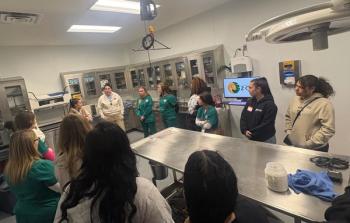
5 ways to enrich patients' environment at your practice
Consider the five senses and create a peaceful practice environment for your stressed-out patients.
Getty Images
Enriching patients' environment is more than just offering toys and treats-it's creating a feeling of choice and allowing each pet to express its breed-specific behaviors safely. Hospitalized cats and dogs that experience an inadequate environment undergo stress that can delay healing, which may create a welfare issue. So your entire team should work diligently to effectively manipulate your patients' environment in order to optimize care. To do so, consider your patients' five senses.
Sight
Pets' visual acuity may be very different from people's. For example, some pets may become overstimulated by movement. Others may not see well and get startled when people or objects “sneak up” on them. Make sure you modify their cages during hospitalization and their treatment space during examination accordingly.
For timid pets that prefer to hide:
- After removing the tops of their carriers, allow these pets to shelter in the lower portion of the carrier—unless removal for examination or other treatments is necessary.
- Cover the patients’ carriers or cage doors with a large towel.
- Shield their heads with a towel or Calming Cap (Premier Pet Products).
- Provide cardboard boxes and tubes for shielding to allow these pets to escape to a quiet, safe place.
For pets that are calmed through visual awareness:
- Allow sighting of people and other animals of the same species.
- Create a shelf as a vantage point: Use a disposable cardboard box for rabbits, ferrets, lizards, cats, and even small dogs. (Larger dogs won’t need extra height.)
- Arrange a climbing branch or perch for cats, ferrets, lizards or birds.
(
Photo courtesy of Sherrie Yuschak
Sound
Researchers have studied bioacoustics in people and pets to reveal how music affects heart rate, brain waves, and respiratory patterns. Strategically composed music that uses optimal tempo and instruments can have a dramatic calming effect on your veterinary patients. Ensure that you're providing a relaxing-and not stimulating-environment.
Here are six ways to decrease the sound exposure in your hospital:
- Decrease the overall noise level with sound-absorbing decor such as fabrics, plants, and wall hangings.
- Provide soothing music, such as the scientifically researched compilations by Through a Dog’s Ear (Phantom Publishing), in your exam rooms, waiting rooms, kennel wards, isolation, and especially in the surgical recovery areas.
- Decrease the pet’s time in the loud common areas by performing triage and bill payment within the exam room. Talk in a calm, soothing voice.
- It’s ideal to establish a separate lobby for dogs and cats. If that’s not possible, buffer and segregate waiting rooms by using furnishings and plants.
- Intervene to minimize stress vocalizations such as barking or yowling. Relocate the patient to a different room or cage. Remove stimulating animals from the patient’s view, cover the cage door with a towel, and add different toys or beddingIf these suggestions don’t work, try putting the patient in a quieter area such as an unused “isolation” ward where there are fewer distractions. Or some dogs just need additional outside potty breaks and extra attention. For intractable cases, be sure to consider out-patient treatment or sedation.
- Try to avoid construction noise in patient-inhabited areas.
(
Photo courtesy of Sherrie Yuschak
Touch
Nerve receptors in pets' whiskers, skin, hair, and other body parts collect environmental data and provide the sense of touch. Pets interpret this data to help establish their degree of safety and determine their comfort level.
Increase your patients’ tactile awareness with these six strategies:
- Use rubber mats to prevent slipping.
- Offer clean, soft bedding for resting.
- Maintain a comfortable environmental temperature—remember some cages are in poorly insulated areas of the hospital. Even if your clinic has central heating or air conditioning, remember to keep animal housing areas at a constant temperature.
- Some patients may require different temperature control—such as additional warming or cooling—which should be addressed with additional warming devices or fans. Good ventilation and hygiene are critical factors as well.
- Provide nurturing touch and avoid isolation for social species like dogs.
- Limit disruption for solitary-seekers.
- Provide manipulative objects when stimulation is warranted. Food-stuffed puzzle toys are great for dogs. Kitty litter secured inside of old syringe cases creates a fun rattle toy for cats.
(
Photo courtesy of Sherrie Yuschak
Taste
Dogs and cats don't get as hungry during times of psychological stress. So lack of appetite can be a strong barometer of anxiety. Diseases and medications can alter taste perception, and nausea can be associated with a particular food. Sometimes the pet doesn't feel like eating due to the physiological shut off of hunger caused by the disease or condition. These are all important factors for your team to take into consideration.
Here are seven ways to improve your patients’ eating habits:
- Feed a highly palatable food.
- Heat up refrigerated food until it’s at room or body temperature.
- Consider the texture and consistency of the food and offer choice. If it’s obvious that a patient is not eating, offer a couple different choices and see what works. Oftentimes hospitalized patients are not getting the food they’re used to and are on a special diet, so each patient must be approached differently.
- Allow for a satiating volume of food, unless the pet’s diet is restricted for specific medical reasons.
- Schedule meals to avoid the discomfort of hunger or excessive fullness.
- Place your patients’ meals in puzzle feeders—hollow, rubber toys—for hours of mental occupation.
- Promptly remove food from nauseated or vomiting patients.
(
Photo courtesy of Sherrie Yuschak
Smell
Pets vary greatly in their ability to perceive scents and their regard of which scents are attractive or repugnant. Many veterinary facilities are maintained to please people's noses without considering the patients.
Make your hospital smell better to pets with these six strategies:
- Use calming pheromones such as D.A.P. or Feliway (Ceva Animal Health) to mask clinical smells.
- Install air fresheners that use lavender, vanillas or another tranquil scent.Be sure to avoid using harsh-smelling detergents. Always remember to rinse alcohol and iodine off of your patients after every treatment.
- Use calming pheromone diffusers in your patients’ rooms.
- Try the diffuser sprays on patients’ bedding, towels, and clothes.
- Instill soothing herbal scents such as lavender or vanilla.
- Avoid strong deodorizers and chemical smells near patients.
(
Photo courtesy of Sherrie Yuschak
Stock up
Your practice probably already owns many items that can be used to enrich patients' environment. And if you need to purchase any, many can be acquired rather cheaply. Choose a convenient storage location and be sure to disinfect the enrichment devices in batches to minimize your cleaning efforts.
Here are some basic enrichment devices that will help keep your patients engaged, comfortable, and happy:
- Cardboard boxes
- Thick towels and blankets
- Non-slip rugs
- Canine and feline pheromone products
- Food-stuffed puzzle toys, either manufactured or self-made
- Shredded paper
- Music
- A variety of palatable foods.
For more tips check out these resources:
- Animal Behavior: Psychobiology, Ethology and Evolution, 3rd Edition by David McFarland (Benjamin Cummings, 1998)
- Clinical Behavioral Medicine for Small Animals by Karen Overall (Mosby, 1997)
Sherrie Yuschak, RVT, is Member at Large for the Society of Veterinary Behavior Technicians.
Newsletter
From exam room tips to practice management insights, get trusted veterinary news delivered straight to your inbox—subscribe to dvm360.






